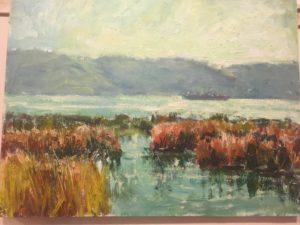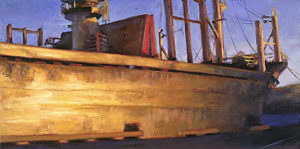
“Fall Brush” by Nikki Basch-Davis, which depicts a view of the Suisun Marsh in the artist’s Impressionistic style, is one of the works that will be on display in Arts Benicia and the Benicia Historical Museum’s collaborative exhibition “Drop By Drop.” (Photo courtesy of Mary Shaw)
Benicia loves its history. Benicia also loves its arts. At last, these two items have come together for a collaborative exhibition by Arts Benicia and the Benicia Historical Museum titled “Drop By Drop: A Brief History of Benicia Water Through the Eyes of its Artists,” which opens Wednesday at the museum.
Coming just off the end of California’s six-year drought and a period of flooding in early 2017, “Drop By Drop” will go over the history of water in Benicia, beginning with its founding as a deep-water port up to its current reputation as a waterfront community.
According to Mary Shaw, Arts Benicia’s exhibitions and programs manager as well as the exhibit’s curator, Arts Benicia received grant money from the Community Sustainability Commission to fund two art exhibits. One was “The Beauty of Water” in the City Hall’s Council Chambers, and the other was “Drop By Drop.” Shaw felt it was an important and relevant exhibit to put on, especially as the drought that squeezed the state dry throughout much of the 2010s remains in a lot of people’s minds.
“Since California is a land of extremes, and we go through these cycles of drought and flood, we know we will get another one,” she said. “Even though the state and the city went through very strong conservation methods during the drought and Californians in general reduced their water usage, it’s always good to keep it in the front of your head because it could happen again.”
Like a lot of museum exhibitions, the exhibit highlights Benicia and California’s water history through timelines on California’s past floods and droughts as well as statewide water projects, and photographic images. However, this exhibit will also feature works of art by local artists delivering their interpretations of Benicia’s water history.
Stephen Schumm’s contributions were watercolor paintings of the Suisun Marsh prior to Benicia’s industrial days, depicting how the scenery looked “as the Spanish saw it for the first time,” according to Shaw.
Marilyn Schaeffer took black and white photographs of significant sites in Benicia’s water history, including the First Street Pier and Mothball Fleet.
Linda Grebmeier’s watercolor paintings capture a more contemporary view of Benicia, namely the boats that come in and dock at ports.
“There’s a lot of beauty to it,” Shaw said of Grebemier’s paintings. “There’s a lot of light and energy.”
Other paintings took on a more personal view, such as Carol Dalton’s illustrations of the human impact on water. Likewise, Lee Wilder Snider portrayed her son looking out into the water.
“It’s nice to have a human element,” Shaw said.
However, not all of the pieces are paintings or photographs. Later in the exhibit, Scott Zoog will create a “reimagined” rain barrel. Also on display will be an installation piece by Larnie and Bodil Fox based on an ancient device called the clepsydra which measures time and is activated through the flow of water. When a switch is turned on, the gentle sounds of water droplets will be broadcast.
In terms of history, the exhibit will detail how Benicians were able to use water in the town’s early days, namely through wells and cisterns that stored water from springs and occasional rains. At one point, the Army had created a water body called Pine Lake off the present site where Interstate 680 becomes 780. The Army would use this source to store water as the Benicia-Martinez Bridge was being retrofitted, but it was drained several decades ago. The Yuba Manufacturing Company had also provided pipes and cranes.
“The Army and the city of Benicia had two separate resources of water, and it was all done through damming, diversion and pumping,” Shaw said. “As Benicia grew and industry grew, the infrastructure had to change.”
Arts Benicia had received a lot of support from the Historical Museum staff, including Museum Curator Beverly Phelan and Exhibits Chair Jim Lessenger, who helped provide a lot of research. Elizabeth D’Huart, the museum’s executive director, was excited at the opportunity to bring various city organizations together.
“I love the fact that we’re bringing three different communities together: the history community, the artist community and the sustainability community,” she said.
Both agreed that the exhibit will be helpful for viewers to see how important water has been for the city in the past and how it remains just as vital.
“I want them to be aware that they shouldn’t take water for granted in California and Benicia,” she said. “The resource we have at our doorstep is not something we can drink. We have to get our water from elsewhere. It costs money to put programs and infrastructure in place. It’s good to have perspective. Where did we come from, where are we now and how are we doing?”
“It is more unusual to have water than not to have water,” D’Huart said. “If people can look at it that way as opposed to the other way, it would change people’s thinking.”
“Drop By Drop” opens Wednesday, July 26 and will be on display through May 27, 2018 at the Benicia Historical Museum, located at 2060 Camel Road. The museum is open from 1 to 4 p.m., Wednesdays through Sundays. An opening reception will be held from 5:30 to 7:30 p.m., Wednesday, which is free and open to the public. Shaw especially hopes that city officials will attend because of their efforts to implement measures during the drought. Arts Benicia is also planning to hold a Family Arts Day, poetry event and panel, but the dates for all are still being determined. For more information, visit artsbenicia.org/drop-by-drop/.







Leave a Reply